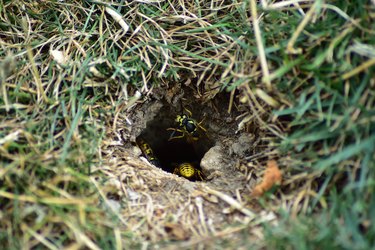
What most people call "ground hornets" aren't really hornets at all. Hornets make paperlike nests that hang from tree branches, roof eaves, and other structures. Yellow jackets, however, make their nests in the ground, as do a few other species of ground wasps. These are the insects people are usually talking about when they use the term "ground hornets." Whatever you call them, these insects can sting, and many people who encounter them care more about getting rid of them than learning their technical names.
A professional exterminator is the best course of action if you really need to remove ground wasps. Otherwise, you put yourself at risk for multiple stings, some of which can cause severe reactions in people. If you're not allergic to stings and find yourself feeling brave, you can attempt to kill these insects yourself.
Video of the Day
Video of the Day
Do They Have To Go?
The best approach to dealing with yellow jackets and other ground wasps is to do nothing. Left to their own devices, yellow jacket colonies die off in the winter. The queen will leave the nest and overwinter elsewhere so she can start a new wasp colony in the spring. The rest of the yellow jackets in the colony will die. Since ground wasps don't reuse old nests, your wasp problem will solve itself when the weather turns cold.
In the meantime, these beneficial insects can help your lawn and garden. Yellow jackets feed aphids, caterpillars, and other garden pests to their growing larvae. They're also good pollinators, visiting many of the same plants as bees. If the nest is located in an area you can avoid, ignoring it is often the easiest and safest course of action.
Dusting the Nest
The safest way to get rid of yellow jackets if you must is to apply insect dust to the nest opening. Wait until nightfall when the wasps are tucked safely in the nest and are unlikely to be active. Put on protective clothing before you set to work just in case. Hopefully, this approach will allow you to attack your prey without ever actually encountering them, but it's better to be prepared than to be stung. Leather gloves, safety goggles, and a thick winter coat should offer adequate protection.
If you need a flashlight, lay it on the ground and position it so that it shines on the nest opening. The light is likely to attract any angry yellow jackets that leave the nest, so put some distance between yourself and the light. Once you're all set up, generously sprinkle a powdered insecticide, like Sevin garden dust, all around the nest opening, letting some fall into the nest opening if you can. Work quickly and vacate the area as soon as possible after applying the dust.
To speed the dusting process and get out of harm's way quickly, fill a plastic cup with the dust and attach it to a long stick or broom handle. When you're ready, simply dump the contents of the cup on top of the nest opening as you walk by and then keep on walking. When the wasps leave the nest, they will walk through the dust, carrying it to other wasps and bringing it with them into the colony as they go in and out. If you're still seeing ground wasps a day or two after treatment, treat the nest again.
Spraying Them Away
Applying insecticidal dust to a yellow jacket nest is effective but takes a day or two to work. If you need to do work near a nest or plan on hosting a family barbecue, you may want something that works more or less immediately. If so, you can shoot the nest with an aerosol spray instead of dusting it. Be warned, however, that a spray is a more confrontational approach and increases your risk of getting stung.
The reason is that wasp nests can be pretty large. When spraying one from a safe distance, the spray is likely to enter the nest but not fill the entire thing. As such, you may have some stoned, angry wasps making a beeline for you once they find their way out of the nest. If you're feeling brave, however, choose an aerosol spray that contains permethrin or lambda-cyhalothrin. Foaming sprays work well.
As with dust, wear protective clothing and avoid holding a flashlight that could paint you as a target. Spray the nest from about 20 feet away, spraying the insecticide for at least 10 full seconds. Quickly vacate the area when you're finished spraying. Expect at least a few angry wasps to follow you unless you're able to channel your inner Usain Bolt and get out of the way in a hurry.